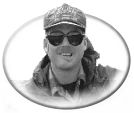
Looking For Clues
with
Philip Rowley
Website
| Email
Choosing a fly
pattern is often a difficult choice. There are thousands of patterns
available. Under the right conditions most should be successful. Do we choose
a dry fly or a nymph? Perhaps a streamer of some kind, what size or color
do we choose? How shall we move it through the water? We often base our
choices upon criteria we choose and not necessarily something the trout
might find appealing.
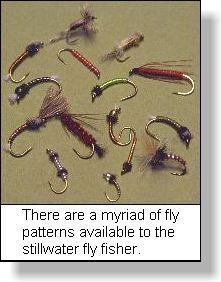 Fly fishing is about imitating the various food sources available for
the fish you are trying to catch. The majority of successful stillwater
fly fishers attempt to imitate something that will trigger a feeding response
as opposed to a response born out of aggression or curiosity. There is no
doubting the success of some attractor patterns, but most are more successful
using more imitative patterns. When we consider the trout, we are fortunate
that they prefer to feed on smaller organisms. While trout are certainly
capable of eating large food items they generally prefer those smaller ones.
They are not as likely to feed upon a frog or other large food item to the
same degree a bass or pike would. This means that they have to open their
mouths to feed more often. Every time they open their mouth to feed is one
more opportunity for us. Remember trout of double digit proportions still
feed upon mayflies, chironomids, and the like.
That is why knowing what trout feed upon in stillwaters is critical to
success. You don't need a degree in Latin to be successful, but you should
be able to distinguish one organism from another. You should know how each
food source behaves and when they are most active and available. As each
fishing season progresses the size of each generation of insect decreases,
in other words Callibaetis mayflies may be a size 12 during the initial
hatches of the season but later on will possibly be a size 14 or smaller.
Even during the hatch the insect size is subject to change. For instance
chironomid larvae will usually be larger than the pupa which in turn is
larger than the adult. Therefore on the surface you may see size 14 adult
chironomids but a size 12 pupa might more approximately match the hatch.
There are also variations in color. When an insect has just emerged into
an adult its color is often lighter than those of older adults, this is
good reason to use lighter patterns when fishing during the hatch. Emerging
pupa or nymphs are often lighter than the adult stage too. Don't forget
to fish the immature stages of the various food sources available to the
trout. We tend to concentrate on patterns that imitate fully mature items,
forgetting trout feed upon large amounts of the immature stages. Choose
small patterns later on in the season. Many of the larger more mature insects
have already hatched in the spring. Remember that some insects such as dragon
flies have species that spend in excess of 3 years as a nymph.
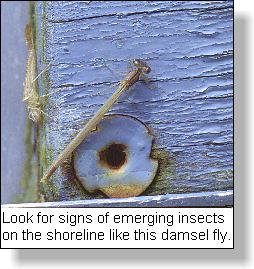 Another successful strategy involves looking for
signs of insect activity or availability. The first tactic involves
some snooping around on shore. Look for signs of recent hatches amongst
or on shoreline vegetation. Docks are another great spot for clues of
a recent hatch. Remember, damsels, dragons and some species of caddis
emerge out of the water so their cast husks are clearly visible. Spider
webs are another great source of information. Often recently hatched
adults can become victims in the spider's web. Turn over logs and rocks
along the shoreline. Look amongst the weeds and other features along
the shoreline. Often the cast husks and those insects that have drowned
during the emergence process end up washed into the shallows. Take note
of what you see not only in quantity but size and color if possible.
If you capture something watch how it moves through the water and adapt
your retrieves to match what you have seen. Once on the water take note
of any husks or shucks you see upon the water. Remember the wind can
drift them from further upwind. Birds are a great indicator of hatches.
The knowledgeable salt water angler uses gulls to identify bait fish
and so can the stillwater angler use bird activity to track down localized
hatches. Birds such as Swallows, Nighthawks and Bonaparte gulls are
all partial to feeding upon insects. Find actively feeding birds and
you should find feeding fish. Another successful strategy involves looking for
signs of insect activity or availability. The first tactic involves
some snooping around on shore. Look for signs of recent hatches amongst
or on shoreline vegetation. Docks are another great spot for clues of
a recent hatch. Remember, damsels, dragons and some species of caddis
emerge out of the water so their cast husks are clearly visible. Spider
webs are another great source of information. Often recently hatched
adults can become victims in the spider's web. Turn over logs and rocks
along the shoreline. Look amongst the weeds and other features along
the shoreline. Often the cast husks and those insects that have drowned
during the emergence process end up washed into the shallows. Take note
of what you see not only in quantity but size and color if possible.
If you capture something watch how it moves through the water and adapt
your retrieves to match what you have seen. Once on the water take note
of any husks or shucks you see upon the water. Remember the wind can
drift them from further upwind. Birds are a great indicator of hatches.
The knowledgeable salt water angler uses gulls to identify bait fish
and so can the stillwater angler use bird activity to track down localized
hatches. Birds such as Swallows, Nighthawks and Bonaparte gulls are
all partial to feeding upon insects. Find actively feeding birds and
you should find feeding fish.
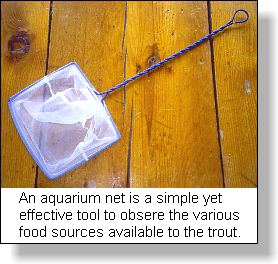 The stillwater fly fisher has a couple of tools that
can help in identifying the food a trout may be feeding upon at any
given time. The first is a simple aquarium net. An aquarium net allows
you to capture swimming nymphs, emerging adults or probe slightly deeper
waters to determine what food sources might be available. The second
tool is the stomach pump, used properly it is an invaluable tool and
one I would not want to be without. You can use the stomach pump to
determine a what depth fish might be feeding. If a sample contains emergers
and adults' chances are the fish are at or near the surface. Often the
organisms a stomach pump removes from the fish are alive. Organisms
that are alive often possess unique characteristics that are often keys
for the trout. Trapped air and gases in various chironomids and caddis
pupa give a distinct glowing appearance that is a key factor for the
foraging trout. I have squirted stomach pump samples into a petry dish
and had my own mini hatches in my boat. Stomach samples from cleaned
fish are another source of information. Be careful however as you can
get yesterday's news depending upon where in the stomach you take your
samples from. Stomach acids also have a negative effect on the color
of the organisms a trout feeds upon. The stomach pump gives you up to
date information and is far easier on the fish, but please don't use
a stomach pump on small fish as it will mostly likely injure them. Make
note of the insects and other food sources you see and after time you
will notice certain preferences and patterns that you can use as reference
for future outings. The stillwater fly fisher has a couple of tools that
can help in identifying the food a trout may be feeding upon at any
given time. The first is a simple aquarium net. An aquarium net allows
you to capture swimming nymphs, emerging adults or probe slightly deeper
waters to determine what food sources might be available. The second
tool is the stomach pump, used properly it is an invaluable tool and
one I would not want to be without. You can use the stomach pump to
determine a what depth fish might be feeding. If a sample contains emergers
and adults' chances are the fish are at or near the surface. Often the
organisms a stomach pump removes from the fish are alive. Organisms
that are alive often possess unique characteristics that are often keys
for the trout. Trapped air and gases in various chironomids and caddis
pupa give a distinct glowing appearance that is a key factor for the
foraging trout. I have squirted stomach pump samples into a petry dish
and had my own mini hatches in my boat. Stomach samples from cleaned
fish are another source of information. Be careful however as you can
get yesterday's news depending upon where in the stomach you take your
samples from. Stomach acids also have a negative effect on the color
of the organisms a trout feeds upon. The stomach pump gives you up to
date information and is far easier on the fish, but please don't use
a stomach pump on small fish as it will mostly likely injure them. Make
note of the insects and other food sources you see and after time you
will notice certain preferences and patterns that you can use as reference
for future outings.
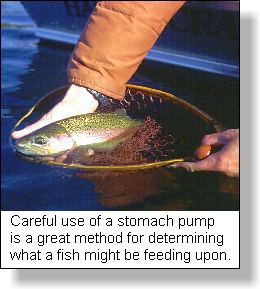 Determining what trout are feeding upon is often
reminiscent of detective work. It can be frustrating full of dead ends
and failures at times. If you stick with it and be observant you will
become more and more successful. You will begin to see things' others
tend to miss. As you position yourself on the lake for the days' fishing
you will be quickly eliminating those patterns that are least likely to
be successful for that day. You will base your fly selection upon the
clues' mother nature has left you. You will cast your offering to the
waiting fish and retrieve it with confidence. One time you will make your
pattern selection and be instantly be rewarded with a fish followed hopefully
by numerous others. Other anglers will stare enviously at you wondering
what you are doing. Most of the time the clues are right under their noses. Determining what trout are feeding upon is often
reminiscent of detective work. It can be frustrating full of dead ends
and failures at times. If you stick with it and be observant you will
become more and more successful. You will begin to see things' others
tend to miss. As you position yourself on the lake for the days' fishing
you will be quickly eliminating those patterns that are least likely to
be successful for that day. You will base your fly selection upon the
clues' mother nature has left you. You will cast your offering to the
waiting fish and retrieve it with confidence. One time you will make your
pattern selection and be instantly be rewarded with a fish followed hopefully
by numerous others. Other anglers will stare enviously at you wondering
what you are doing. Most of the time the clues are right under their noses.

Philip Rowley
|





 Another successful strategy involves looking for
signs of insect activity or availability. The first tactic involves
some snooping around on shore. Look for signs of recent hatches amongst
or on shoreline vegetation. Docks are another great spot for clues of
a recent hatch. Remember, damsels, dragons and some species of caddis
emerge out of the water so their cast husks are clearly visible. Spider
webs are another great source of information. Often recently hatched
adults can become victims in the spider's web. Turn over logs and rocks
along the shoreline. Look amongst the weeds and other features along
the shoreline. Often the cast husks and those insects that have drowned
during the emergence process end up washed into the shallows. Take note
of what you see not only in quantity but size and color if possible.
If you capture something watch how it moves through the water and adapt
your retrieves to match what you have seen. Once on the water take note
of any husks or shucks you see upon the water. Remember the wind can
drift them from further upwind. Birds are a great indicator of hatches.
The knowledgeable salt water angler uses gulls to identify bait fish
and so can the stillwater angler use bird activity to track down localized
hatches. Birds such as Swallows, Nighthawks and Bonaparte gulls are
all partial to feeding upon insects. Find actively feeding birds and
you should find feeding fish.
Another successful strategy involves looking for
signs of insect activity or availability. The first tactic involves
some snooping around on shore. Look for signs of recent hatches amongst
or on shoreline vegetation. Docks are another great spot for clues of
a recent hatch. Remember, damsels, dragons and some species of caddis
emerge out of the water so their cast husks are clearly visible. Spider
webs are another great source of information. Often recently hatched
adults can become victims in the spider's web. Turn over logs and rocks
along the shoreline. Look amongst the weeds and other features along
the shoreline. Often the cast husks and those insects that have drowned
during the emergence process end up washed into the shallows. Take note
of what you see not only in quantity but size and color if possible.
If you capture something watch how it moves through the water and adapt
your retrieves to match what you have seen. Once on the water take note
of any husks or shucks you see upon the water. Remember the wind can
drift them from further upwind. Birds are a great indicator of hatches.
The knowledgeable salt water angler uses gulls to identify bait fish
and so can the stillwater angler use bird activity to track down localized
hatches. Birds such as Swallows, Nighthawks and Bonaparte gulls are
all partial to feeding upon insects. Find actively feeding birds and
you should find feeding fish. The stillwater fly fisher has a couple of tools that
can help in identifying the food a trout may be feeding upon at any
given time. The first is a simple aquarium net. An aquarium net allows
you to capture swimming nymphs, emerging adults or probe slightly deeper
waters to determine what food sources might be available. The second
tool is the stomach pump, used properly it is an invaluable tool and
one I would not want to be without. You can use the stomach pump to
determine a what depth fish might be feeding. If a sample contains emergers
and adults' chances are the fish are at or near the surface. Often the
organisms a stomach pump removes from the fish are alive. Organisms
that are alive often possess unique characteristics that are often keys
for the trout. Trapped air and gases in various chironomids and caddis
pupa give a distinct glowing appearance that is a key factor for the
foraging trout. I have squirted stomach pump samples into a petry dish
and had my own mini hatches in my boat. Stomach samples from cleaned
fish are another source of information. Be careful however as you can
get yesterday's news depending upon where in the stomach you take your
samples from. Stomach acids also have a negative effect on the color
of the organisms a trout feeds upon. The stomach pump gives you up to
date information and is far easier on the fish, but please don't use
a stomach pump on small fish as it will mostly likely injure them. Make
note of the insects and other food sources you see and after time you
will notice certain preferences and patterns that you can use as reference
for future outings.
The stillwater fly fisher has a couple of tools that
can help in identifying the food a trout may be feeding upon at any
given time. The first is a simple aquarium net. An aquarium net allows
you to capture swimming nymphs, emerging adults or probe slightly deeper
waters to determine what food sources might be available. The second
tool is the stomach pump, used properly it is an invaluable tool and
one I would not want to be without. You can use the stomach pump to
determine a what depth fish might be feeding. If a sample contains emergers
and adults' chances are the fish are at or near the surface. Often the
organisms a stomach pump removes from the fish are alive. Organisms
that are alive often possess unique characteristics that are often keys
for the trout. Trapped air and gases in various chironomids and caddis
pupa give a distinct glowing appearance that is a key factor for the
foraging trout. I have squirted stomach pump samples into a petry dish
and had my own mini hatches in my boat. Stomach samples from cleaned
fish are another source of information. Be careful however as you can
get yesterday's news depending upon where in the stomach you take your
samples from. Stomach acids also have a negative effect on the color
of the organisms a trout feeds upon. The stomach pump gives you up to
date information and is far easier on the fish, but please don't use
a stomach pump on small fish as it will mostly likely injure them. Make
note of the insects and other food sources you see and after time you
will notice certain preferences and patterns that you can use as reference
for future outings. Determining what trout are feeding upon is often
reminiscent of detective work. It can be frustrating full of dead ends
and failures at times. If you stick with it and be observant you will
become more and more successful. You will begin to see things' others
tend to miss. As you position yourself on the lake for the days' fishing
you will be quickly eliminating those patterns that are least likely to
be successful for that day. You will base your fly selection upon the
clues' mother nature has left you. You will cast your offering to the
waiting fish and retrieve it with confidence. One time you will make your
pattern selection and be instantly be rewarded with a fish followed hopefully
by numerous others. Other anglers will stare enviously at you wondering
what you are doing. Most of the time the clues are right under their noses.
Determining what trout are feeding upon is often
reminiscent of detective work. It can be frustrating full of dead ends
and failures at times. If you stick with it and be observant you will
become more and more successful. You will begin to see things' others
tend to miss. As you position yourself on the lake for the days' fishing
you will be quickly eliminating those patterns that are least likely to
be successful for that day. You will base your fly selection upon the
clues' mother nature has left you. You will cast your offering to the
waiting fish and retrieve it with confidence. One time you will make your
pattern selection and be instantly be rewarded with a fish followed hopefully
by numerous others. Other anglers will stare enviously at you wondering
what you are doing. Most of the time the clues are right under their noses.